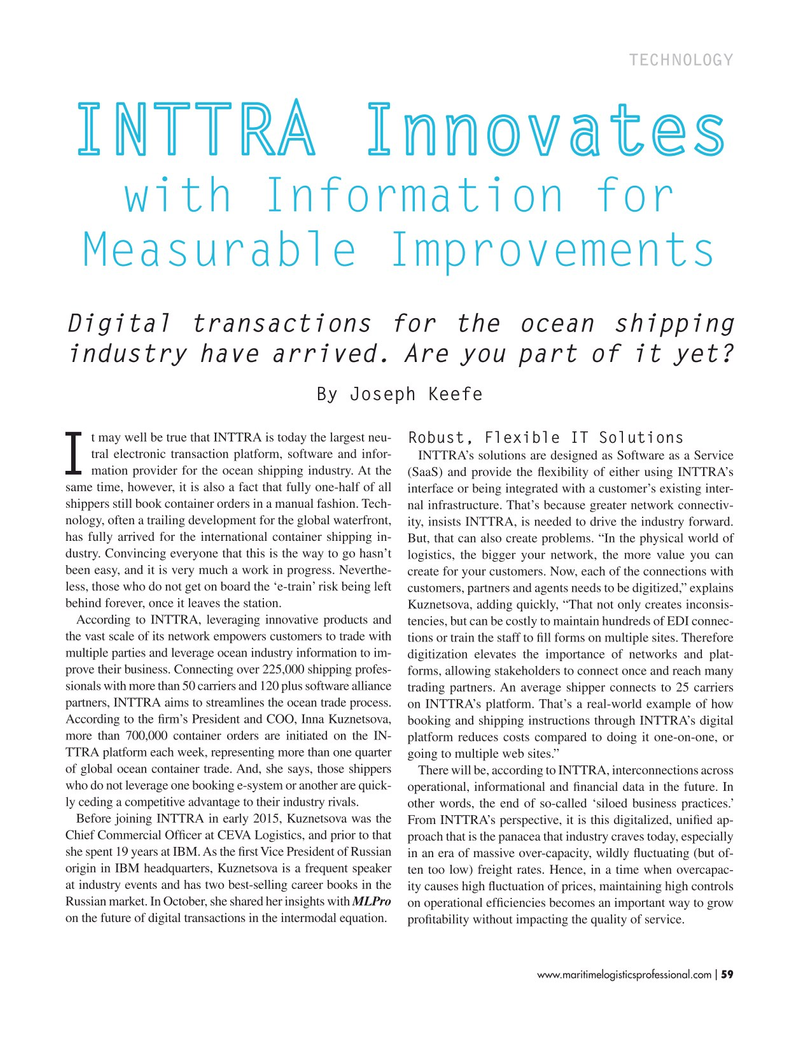
Page 59: of Maritime Logistics Professional Magazine (Sep/Oct 2017)
CONTAINER PORTS
Read this page in Pdf, Flash or Html5 edition of Sep/Oct 2017 Maritime Logistics Professional Magazine
TECHNOLOGY with Information for
Measurable Improvements
Digital transactions for the ocean shipping industry have arrived. Are you part of it yet?
By Joseph Keefe t may well be true that INTTRA is today the largest neu-
Robust, Flexible IT Solutions tral electronic transaction platform, software and infor-
INTTRA’s solutions are designed as Software as a Service
Imation provider for the ocean shipping industry. At the (SaaS) and provide the fexibility of either using INTTRA’s same time, however, it is also a fact that fully one-half of all interface or being integrated with a customer’s existing inter- shippers still book container orders in a manual fashion. Tech- nal infrastructure. That’s because greater network connectiv- nology, often a trailing development for the global waterfront, ity, insists INTTRA, is needed to drive the industry forward. has fully arrived for the international container shipping in-
But, that can also create problems. “In the physical world of dustry. Convincing everyone that this is the way to go hasn’t logistics, the bigger your network, the more value you can been easy, and it is very much a work in progress. Neverthe- create for your customers. Now, each of the connections with less, those who do not get on board the ‘e-train’ risk being left customers, partners and agents needs to be digitized,” explains behind forever, once it leaves the station.
Kuznetsova, adding quickly, “That not only creates inconsis-
According to INTTRA, leveraging innovative products and tencies, but can be costly to maintain hundreds of EDI connec- the vast scale of its network empowers customers to trade with tions or train the staff to fll forms on multiple sites. Therefore multiple parties and leverage ocean industry information to im- digitization elevates the importance of networks and plat- prove their business. Connecting over 225,000 shipping profes- forms, allowing stakeholders to connect once and reach many sionals with more than 50 carriers and 120 plus software alliance trading partners. An average shipper connects to 25 carriers partners, INTTRA aims to streamlines the ocean trade process. on INTTRA’s platform. That’s a real-world example of how
According to the frm’s President and COO, Inna Kuznetsova, booking and shipping instructions through INTTRA’s digital more than 700,000 container orders are initiated on the IN- platform reduces costs compared to doing it one-on-one, or
TTRA platform each week, representing more than one quarter going to multiple web sites.” of global ocean container trade. And, she says, those shippers
There will be, according to INTTRA, interconnections across who do not leverage one booking e-system or another are quick- operational, informational and fnancial data in the future. In ly ceding a competitive advantage to their industry rivals. other words, the end of so-called ‘siloed business practices.’
Before joining INTTRA in early 2015, Kuznetsova was the From INTTRA’s perspective, it is this digitalized, unifed ap-
Chief Commercial Offcer at CEVA Logistics, and prior to that proach that is the panacea that industry craves today, especially she spent 19 years at IBM. As the frst Vice President of Russian in an era of massive over-capacity, wildly fuctuating (but of- origin in IBM headquarters, Kuznetsova is a frequent speaker ten too low) freight rates. Hence, in a time when overcapac- at industry events and has two best-selling career books in the ity causes high fuctuation of prices, maintaining high controls
Russian market. In October, she shared her insights with MLPro on operational effciencies becomes an important way to grow on the future of digital transactions in the intermodal equation.
proftability without impacting the quality of service.
www.maritimelogisticsprofessional.com 59
I

 58
58

 60
60
